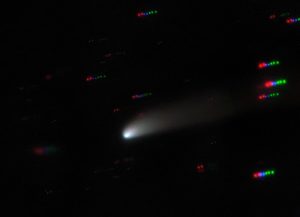
The former Chair of Harvard University’s Astronomy Department, Avi Loeb, has provided an update on the material collected from the first known interstellar meteorite to strike the Earth, Interstellar meteor (IM1); not only does this early analysis bolster the idea that IM1 is from beyond our solar system, but Loeb has also found another candidate that impacted the Atlantic Ocean in 2017.
On April 13, 2022, a memo from U.S. Space Command was released confirming that a meteor designated CNEOS 2014-01-08 was travelling at roughly 60 kilometers per second (37.3 miles per second) when it impacted the Earth on January 8, 2014—a speed far too fast to be an object bound by the gravity of the Sun, meaning it had to have originated from interstellar space.
This confirmed the calculations regarding CNEOS 2014-01-08’s trajectory that were published by Harvard astrophysicist Amir Siraj, who, along with paper co-author Loeb, calculated that the half-meter (1.5-foot) object’s speed was three times greater than that of something that would be able to stay in orbit around the Sun.
Because CNEOS 2014-01-08, now re-designated as Interstellar meteor 1, or IM1, was tracked during its entry into the atmosphere, the area where it should have impacted was easily determined: a spot in the Indian Ocean just northeast of Papua New Guinea. Knowing the area where a potential interstellar object might be found prompted Loeb and Siraj to launch an expedition to recover any debris that may have survived the object’s high-speed impact with the atmosphere.
The expedition struck meteoric gold on June 21: the magnetic sled dredging samples of iron from the seabed had collected a number of tiny, millimeter-sized iron spherules that resembled the blobs of molten metal that form when a metallic meteorite tears through the atmosphere. A preliminary analysis indicated that the material that comprised the tiny pearl-like object of was from outside the solar system, hinting that IM1 was indeed from beyond the stars.
In all, the expedition recovered 722 spherules from the bottom of the Indian Ocean, which were dubbed “BeLaU spherules” by Harvard geochemist Stein Jacobsen, due to the high concentrations of beryllium, lanthanum, and uranium found in the samples. The concentrations of the lanthanum and uranium were substantially higher than what is found in Earthly rocks—by 500 times—indicating that the material did not originate in our solar system.
The levels of beryllium in the samples, also hundreds of times higher than what would be found on Earth, was particularly unusual, because the element is typically formed through a possess called “spallation“, blown out of the nuclei of heavier elements by the impact of high-energy cosmic rays.
“That is a flag of interstellar travel,” according to Loeb: elements within our solar system are, for the most part, protected from the bombardment of such radiation due to the constant outward pressure of the solar wind; without the protection of a nearby star, elements like beryllium are formed at a much higher rate.
Additionally, the iron present in the spherules has a different isotopic ratio than that of iron found here at home, another mark of an extra-solar object: on Earth, iron has four stable isotopes—variations on the same element that have the same number of protons and electrons, but a different number of neutrons—that are found in a specific ratio to one-another, with regular iron-56 making up a little under 92 percent of the mix; however, on a planet borne of another star this ratio will be different.
“It clearly came from outside,” Loeb remarked. The preliminary analysis of the material also found that the uranium found in the samples also had isotopic ratios that indicated an extra-solar origin.
The elemental composition of IM1 indicates that the object originated from a much larger one that was big enough to have formed differentiated layers like the crust, mantle and core found in bodies such as planets or large asteroids like Ceres. Loeb and his team are now looking at a possible second interstellar candidate, IM2, which exploded off of the Portuguese coast in 2017. If IM2 does prove to be another object from outside the solar system, that might mean that IM1 wasn’t just a fortunate coincidence, but that Earth might intercept interstellar material on a more frequent basis than previously assumed.
“A random detection rate of 1 per decade for meter-sized interstellar objects [hitting Earth] implies that a few million such objects reside within the orbit of the Earth around the Sun at any given time,” Loeb explained. He hopes that “some of them may represent technological space trash from other civilizations”.
Subscribers, to watch the subscriber version of the video, first log in then click on Dreamland Subscriber-Only Video Podcast link.